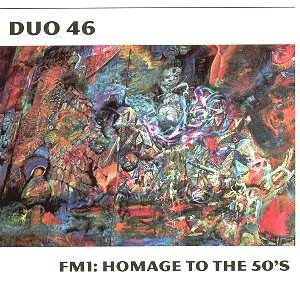FM1: HOMAGE TO THE 50'S
Music for Guitar and Violin composed 1952 - 1956
Bruno BARTOLOZZI
Serenata
Waldemar BLOCH Sonate
Siegfried BEHREND Spielmusik
Albert REITER Sonatine
Otto SIEGL Sonatine in d minor
Jenö TAKÁCS
Divertimento
Jan TRUHLÁR Zwei
Kompositionen
 DUO 46 - Matthew Gould, Spanish
Guitar & Beth Ilana Schneider, Violin
DUO 46 - Matthew Gould, Spanish
Guitar & Beth Ilana Schneider, Violin
 Guitar Plus Records GPR
100198 [50:50]
Guitar Plus Records GPR
100198 [50:50]

Ironically the programme time of this disc (see above) really rather sums
up the whole enterprise, in a number of different ways. Of the two players
it is Matthew Gould who provides the finer musicianship and demonstrates
complete control over his 1995 Mischa Roberts 'classical' guitar. Perhaps
this is only to be expected on a specialist guitar label. Unfortunately Beth
Ilana Schneider suffers from occasional lapses of intonation and her choice
of a tight and closed sounding 1985 Bulfari violin for three of the seven
works hardly helps.
Then there's the music. The back of the booklet incorporates a short essay
- perhaps prose poem might more adequately describe it - by David M. Williams
entitled Power, Perfection and Paranoia which amusingly parodies and mocks
the extraordinary post-war American society of the '50s with its contradictions,
growth of suburbanisation, female and minority suppression, McCarthyism and
the growing dominance of television. The Cold War was growing ever colder.
Printed separately from the normal (and much more sober) sleeve notes, one
can only assume that Williams is providing a background to the difficult
and often unsatisfactory post-war era in musical composition, without actually
saying so. If this is the case, then he's absolutely right about the works
featured on this CD.
xxxxx Serenata by Bruno Bartolozzi and Sonate by Waldemar Bloch
are both typical examples of the arid note-spinning so common at this period
among a younger generation of composers who were finding it almost impossible
to break away from the strictures of pre-war modernism and the shadow of
the Viennese 'masters'. In particular Bloch's Sonate sounds more like
an academic exercise than real music, wit without melody, a meandering slow
movement is followed by a finale that hurries and scurries for effect, rather
than any discernible effectiveness. Well-known German guitarist and composer
Siegfried Behrend surprisingly fails to improve matters with a tentatively
tonal five-movement suite, Spielmusik which somehow fails to gel.
But that's just about fifty percent of the disc's contents. The anonymous
sleeve-note writer squeamishly describes the remainder as old-fashioned and
conservative, yet to these ears it is considerably more inventive, moving
and significant. Albert Reiter's Sonatine would not sound out of place
in a concert of today's contemporary music. Suddenly accelerandi and 'rits'
are back in favour, the players are requested to incorporate shifts in colour
and timbre (particularly the guitar), the music moves from soft to loud and
each movement has a point of climax and a meaningful closing passage.
Much the same could be said of Otto Siegl's Sonatine in d minor and
Jenö Takács' Divertimento, the former displaying a fine
use of dynamic in the outer movements with an affecting slow movement, the
latter, in three very different movements stylistically, a well crafted homage
à JS Bach in the opening Praeludium, a slow movement incorporating
the full range of the violin in long held notes and chords (and bird calls)
punctuated by brief chordal comments from the guitar, and a Gigue
finale worthy of repeat listening even though the violinist occasionally
finds the music taxing.
Finally Jan Truhlár's Zwei Kompositionen ends the disc in a
mood utterly remote from thoughts of post-war austerity, doubt and political
tensions. The first movement is a dance and, particularly in the context
of the rest of this CD, could almost be described as light music. The
Romanze features a real gypsy-like melody (one only wishes the Bulfari
could allow the player to 'sing' more) and takes us gently back to music
as art form.
So, it's 50/50. A curiously contradictory disc, clearly of serious intent,
yet aspects such as the use of the words "Hit List' instead of 'track list',
the revelation in the booklet that 'FM1' (on the cover) actually means Funeral
Music One (not sure why) and the preposterous claim on the back of the CD
that 'The first time you hear this recording will be one of the most startling
experiences of your life' all conspire to a feeling of confusion.
I am only half convinced.
(For more information about DUO 46 visit
www.duo46.com)
Reviewer
Simon Foster

